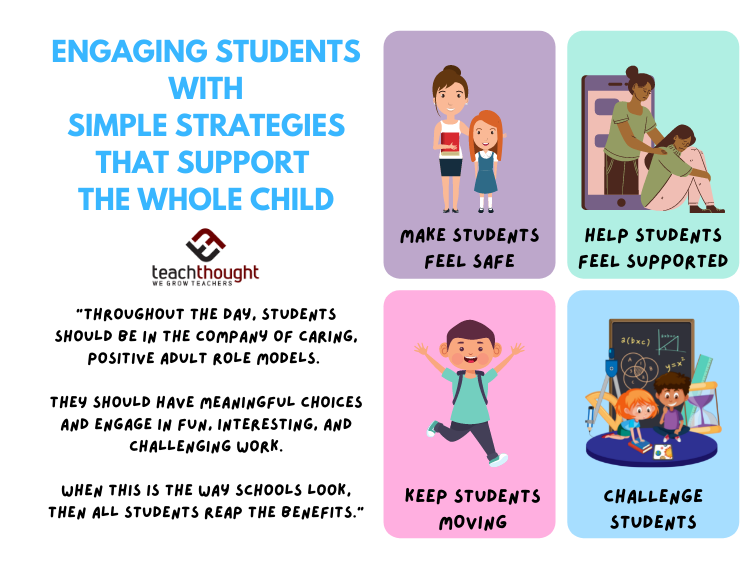
Engaging Students With Simple Strategies That Support The Whole Child
contributed by Mike Anderson
Few would argue with the importance of educating the whole child.
Even in today’s age of standardized testing and emphasis on academic standards, perhaps even because of this recent emphasis, educators are increasingly aware of the need to nurture students’ complete development.
As I work with schools and talk with educators, I see a common way of supporting the whole child that I’d like to push back against. Too often, schools seem to rely on extra-curricular activities and afterschool programs to meet students’ needs for physical health, extra academic challenge and engagement, and more meaningful connections with adults. Now, don’t get me wrong—extra-curricular activities and special afterschool programs and events can be wonderful. My own children, both in middle school, participate in clubs, sports, and musical groups that are powerful and important in their lives and which clearly help nurture their development as whole people.
Perhaps it’s my bias as a classroom teacher that has me pushing back a bit, for I firmly believe that while extra-curricular activities can be one way of educating our children in more complete ways, they had better not be the main way in which we do so. This is important for two reasons. The first is that many children are unable to participate in outside activities. They may have to work or support their families. They may not have the resources or parental support needed to stay after school.
If extra-curricular activities are our main vehicle, the students who would most benefit from a whole child approach will be least likely to get it.
Second, I worry about a subtle message that may be sent when the most engaging, supportive, and interesting work happens outside of the regular curriculum. Some students might come to believe that academic work is something to slog through—to endure. The fun learning happens in the band room, on the baseball field, on the ropes course, or in the afterschool art class.
Instead, schools that are working at educating the whole child should work to accomplish their goals within the context of the regular school day, as a part of everyday teaching and learning. We should make sure that algebra, reading workshops, biology, music, and social studies are challenging, supportive, safe, and engaging. Music, drama, and other arts should be integrated into daily academic work.
In every class, students should learn how to take care of their physical and emotional needs to do their best learning, should have access to healthy foods, and should get to move as they learn. In each class, students should feel safe enough to take the risks needed to engage in meaningful learning. Throughout the day, students should be in the company of caring and supportive adults who are positive role models. Throughout their academic day, students should have meaningful choices and engage in fun, interesting, and appropriately challenging work.
And when this is the way schools look—when students are safe, supported, healthy, engaged, and challenged throughout the day in every class—then all students reap the benefits.
A Few Simple Ideas for Implementation
There are lots of ways we can make our daily teaching better meet the needs of the whole child. Here are a few quick ideas to get you started.
Make sure students feel safe
Have students co-create rules for your classroom and refer to rules frequently to help guide positive behavior. (“Our rules say that we should ‘be respectful.’ What are some ways we can do that as we work with our lab partners?”)
Help students feel supported
Get to know your students. Keep a simple note-sheet where you can jot down information about students’ friends, family, and interests. Talk with students about this knowledge so they know they are known.
Keep them moving
Keep students moving. Have them rotate through the room solving problems posted on charts. Use conversation structures that have students standing and circulating as they share and learn with each other.
Think engagement first, content second
Think through your lessons from your students’ perspectives. Ask yourself, “If I was a student, would I care about this content/activity?” If the answer is ‘probably not,’ find ways of connecting the work to what students value.
Challenge students
Empower students to challenge themselves as they work. Give them some choices about what or how they learn, and encourage them to create their own ‘just right’ challenge level. Remember, work that’s too easy is boring—appropriate challenges are fun!
Mike Anderson is a professional development specialist and educational consultant. A former Milken Award winner, he taught 3rd, 4th, and 5th grades in public schools in New Hampshire and Connecticut for 15 years and was previously a Responsive Classroom® consultant, presenter, and developer. His books have been released by leading publishers, such as ASCD and Heinemann, and include The Well-Balanced Teacher: How to Work Smarter and Stay Sane Inside the Classroom and Out (ASCD, 2010). Learn more about Mike’s work at www.leadinggreatlearning.com; A version of this blog was posted to Mike’s website, Leading Great Learning; image attribution flickr user skokiesculpturepark; The Benefit Of Making The Curricular More Like The Extracurricular
